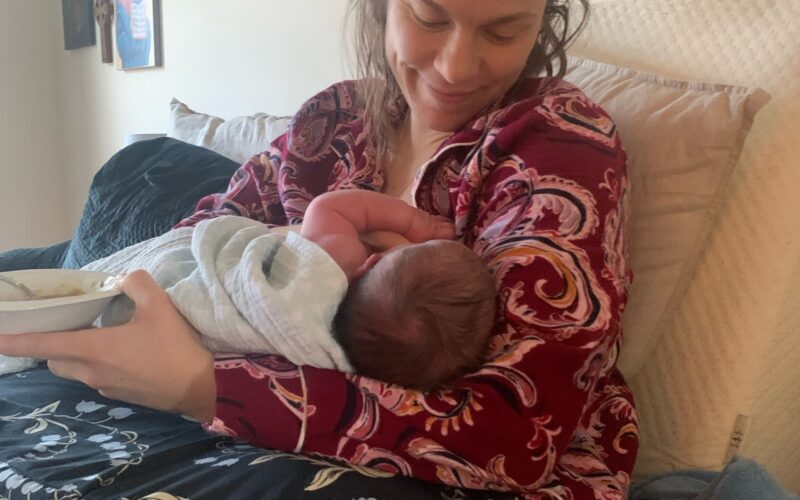My journey with fertility awareness and its application to family planning (aka Natural Family Planning, or “NFP”) is a great example of how fertility awareness methods (FAMs) suit women across the spectrum of their fertility and family planning goals. While some couples learn about NFP before getting married, all of my learning has taken place durante marriage as we’ve been alternately trying to avoid pregnancy, trying to conceive, and while postpartum and breastfeeding. In fact, sometimes it’s been challenging to follow the “rules” because I’ve been pregnant or breastfeeding for the last 7.5 years! Still, with NFP, none of my four children have “surprises,” unless you count the utter shock that we’re now able to conceive so quickly after two years of primary infertility.
Ultimately, I hope my story helps women to know that even though learning and using NFP while in the thick of family planning can be challenging, it es possible.
My first exposure to Natural Family Planning
The first time I heard of NFP was from my older sister. She is 8 years older than me, and got married when I was in high school. She and I had a close enough relationship that she told me about her and her husband’s plans for a baby in the future, but that they were also not ready for a baby in early marriage.
She mentioned Natural Family Planning and periodic condom use after she had tried hormonal birth control and didn’t like its side effects. But when it came to learning more about fertility awareness as a body literacy tool, or how to monitor the biomarkers of fertility that make NFP possible, I knew nothing.
Breaking up with birth control after its negative side effects
When my husband and I first got married, I went on hormonal birth control because I was in nursing school and knew of no other way to prevent a pregnancy. Even though I vaguely knew about my sister’s use of Natural Family Planning, my mom had always steered me in a different direction, saying, “Oh that’s just a rhythm method and it won’t work… better plan for a baby in six months if that’s what you choose to do.”
Even though I vaguely knew about my sister’s use of Natural Family Planning, my mom had always steered me in a different direction, saying, “Oh that’s just a rhythm method and it won’t work… better plan for a baby in six months if that’s what you choose to do.”
So, I went on hormonal birth control, and put learning more about NFP on the back burner until we were ready for a baby. But the time for learning about NFP came sooner than expected when hormonal birth control caused me one issue after another, including insomnia, breakthrough bleeding, and horrible mood swings. When my husband and I finally decided to break up with birth control, it took me another few months to dive into fertility awareness methods.
Getting started with Natural Family Planning and choosing a method
After a few months off hormonal birth control, my period still hadn’t returned. I used that time to learn all I could about fertility awareness, and chose to read Tome las riendas de su fertilidad by Toni Weschler upon my older sister’s recommendation.
Weschler’s book describes a modified version of the método sintotérmico, but the book also educates women on using cervical position and luteinizing hormone (LH) strips for additional fertility biomarkers. I dove into taking my temperatura corporal basal and charting my fluido cervical immediately. However, this proved challenging due to long cycles and inconsistent cervical fluid patterns.
It wasn’t until I dove into natural remedies to try to conceive that I started to notice my true fertile signs, and was able to see a “normal” temperature curve that marked and confirmed ovulation along with the rise and fall of fertile cervical fluid.
It was incredible to finally observe a “normal” chart that confirmed ovulation. I felt blessed that my body was working, and I was thankful to have the information to understand what my body was telling me.
It was incredible to finally observe a “normal” chart that confirmed ovulation. I felt blessed that my body was working, and I was thankful to have the information to understand what my body was telling me.
Ready for a baby: NFP helped us get pregnant y identify my baby’s true “due date”
It took about a year of charting, two miscarriages, and a drastic dietary shift to finally conceive my first daughter. And NFP was an incredible tool all along. Even though it took longer than we liked to conceive, I loved getting to know my cycle. Plus, knowing my fertile signs made me more aware of when my husband and I should be intimate. Before learning my fertile signs, it always felt like a shot in the dark!
When we finally conceived, I knew exactly when conception happened, and it gave me a more accurate “due date.” However, given my my long cycles, my OB gave me a due date one week prior to what my ovulation date predicted it should be. Unfortunately, even with my temperature charts roughly confirming the date of ovulation, he still went with the outdated “Naegele’s rule” formula for predicting due date.
(In the end, I believe that’s why I was induced, rather than allowed to wait for when my daughter was actually ready to join us. Fortunately, my subsequent healthcare teams have used my temperature charts and fertility signs as the true predictor for my “due dates.”)
Using NFP postpartum
After my first daughter was born, I knew to observe my cervical fluid, but I didn’t anticipate the many “false starts” that can come while breastfeeding. I would experience a patch of fertile cervical fluid, only for it to go away and not result in ovulation. It was challenging and made my husband and I have many hard conversations.
Each postpartum return to fertility has happened at different times, which has added another twist to my Natural Family Planning journey. But each time we’ve successfully navigated the challenges, it’s left me feeling more confident than ever in my body and my ability to read my fertile signs.
The challenges of Natural Family Planning caused better communication
I don’t want to gloss over the challenges that may come with using NFP postpartum, because it can be a notoriously tricky time to learn and/or use NFP. In fact, some women even switch methods at this time. I have explored other methods of NFP, but at this time, I don’t have the resources to learn something like the Marquette Method or the Creighton Model, which some women find easier postpartum.
Estoy agradecido por Tome las riendas de su fertilidad because of its wide array of educational resources on all fertile signs. It’s spurred my husband and I to have numerous in-depth conversations about NFP, and that has brought us closer together. It’s also helped me realize the importance of good communication with my husband about the signs of my fertility, so that we stay on the same page with our family planning goals.
The unexpected blessings of Natural Family Planning
Throughout my NFP journey, I’ve come to realize that my and my husband’s fertility is ours–it isn’t just my responsibility, but a mutual relationship that requires constant communication and respect. Finally, after 11 years of marriage and four babies, I feel confident in my observations, and my husband trusts me to communicate with him about them. These are both wonderful things!
An added bonus to my journey with NFP is that it has helped me find my niche in the world. Without my journey with hormonal birth control, natural remedies, NFP/FAM, I don’t think I would have discovered this incredible world of natural women’s health. I love discussing physiology as God intended, with the backing of evidence and wisdom. I tell as many women as I can about the benefits of natural family planning, and I would love to become a certified instructor someday when life with four children allows.






